Extreme Fast Charging Technology—Prospects to Enhance Sustainable Electric Transportation
Abstract
1. Introduction
2. Background
2.1. Specifications of Popular EVs
2.2. Classification of Battery Chargers and Connectors
2.3. AC Charging Connectors
2.3.1. Type 1 Connector
2.3.2. Type 2 Connector
2.3.3. Tesla US Connector
2.4. DC Charging Connectors
2.4.1. CCS Combo 1 and Combo 2
2.4.2. CHAdeMO
2.4.3. Tesla DC Connector
2.4.4. China GB/T Connector
3. State of the Art DC Fast Charging Infrastructure
3.1. Common AC Bus Configuration
3.2. Common DC Bus Configurations
4. SST-Based XFC Infrastructure
5. Challenges and Opportunities in Adopting SST-Based XFC Architectures
5.1. Challenges
5.2. Opportunities
5.2.1. Wide Bandgap Devices
5.2.2. Advances in Magnetics
5.2.3. Smart Charging Techniques
5.2.4. Applications of Smart Charging Techniques
6. Conclusions
Author Contributions
Funding
Conflicts of Interest
References
- Wirasingha, S.G.; Emadi, A. Classification and Review of Control Strategies for Plug-In Hybrid Electric Vehicles. IEEE Trans. Veh. Technol. 2011, 60, 111–122. [Google Scholar] [CrossRef]
- Matthew, M.; Clément, R.; Eric, W. Meeting 2025 Zero Emission Vehicle Goals: An Assessment of Electric Vehicle Charging Infrastructure in Maryland. Available online: Https://www.nrel.gov/docs/fy19osti/71198.pdf (accessed on 1 June 2019).
- Hannan, M.A.; Hoque, M.M.; Hussain, A.; Yusof, Y.; Ker, P.J. State-of-the-Art and Energy Management System of Lithium-Ion Batteries in Electric Vehicle Applications: Issues and Recommendations. IEEE Access 2018, 6, 19362–19378. [Google Scholar] [CrossRef]
- Gao, Y.; Zhang, X.; Cheng, Q.; Guo, B.; Yang, J. Classification and Review of the Charging Strategies for Commercial Lithium-Ion Batteries. IEEE Access 2019, 7, 43511–43524. [Google Scholar] [CrossRef]
- Ahmed, S.; Bloom, I.; Jansen, A.N.; Tanim, T.; Dufek, E.J.; Pesaran, A.; Zhang, J. Enabling fast charging—A battery technology gap assessment. J. Power Sour. 2017, 367, 250–262. [Google Scholar] [CrossRef]
- Collin, R.; Miao, Y.; Yokochi, A.; Enjeti, P.; Jouanne, A. Advanced Electric Vehicle Fast-Charging Technologies. Energies 2019, 12, 1839. [Google Scholar] [CrossRef]
- Williamson, S.S.; Rathore, A.K.; Musavi, F. Industrial Electronics for Electric Transportation: Current State-of-the-Art and Future Challenges. IEEE Trans. Ind. Electron. 2015, 62, 3021–3032. [Google Scholar] [CrossRef]
- Khaligh, A.; Dusmez, S. Comprehensive Topological Analysis of Conductive and Inductive Charging Solutions for Plug-In Electric Vehicles. IEEE Trans. Veh. Technol. 2012, 61, 3475–3489. [Google Scholar] [CrossRef]
- Vehicle On-Board Charger. 2018. Available online: https://www.tesla.com/support/home-charging-installation-redirect (accessed on 1 June 2019).
- Yilmaz, M.; Krein, P.T. Review of Battery Charger Topologies, Charging Power Levels, and Infrastructure for Plug-In Electric and Hybrid Vehicles. IEEE Trans. Power Electron. 2013, 28, 2151–2169. [Google Scholar] [CrossRef]
- Khaligh, A.; D’Antonio, M. Global Trends in High-Power On-Board Chargers for Electric Vehicles. IEEE Trans. Veh. Technol. 2019, 68, 3306–3324. [Google Scholar] [CrossRef]
- Renault Zoe 2018. Available online: Https://www.renault.co.uk/vehicles/new-vehicles/zoe.html (accessed on 1 May 2019).
- Ronanki, D.; Williamson, S.S. Modular Multilevel Converters for Transportation Electrification: Challenges and Opportunities. IEEE Trans. Transp. Electrif. 2018, 4, 399–407. [Google Scholar] [CrossRef]
- Rivera, S.; Wu, B.; Kouro, S.; Yaramasu, V.; Wang, J. Electric Vehicle Charging Station Using a Neutral Point Clamped Converter With Bipolar DC Bus. IEEE Trans. Power Electron. 2013, 12, 5793–5803. [Google Scholar] [CrossRef]
- Bai, S.; Lukic, S.M. Unified Active Filter and Energy Storage System for an MW Electric Vehicle Charging Station. IEEE Trans. Power Electron. 2013, 12, 5793–5803. [Google Scholar] [CrossRef]
- Aggeler, D.; Canales, F.; Zelaya-De La Parra, H.; Coccia, A.; Butcher, N.; Apeldoorn, O. Ultra-fast DC-charge infrastructures for EV-mobility and future smart grids. In Proceedings of the IEEE PES Innovative Smart Grid Technologies Conference Europe (ISGT Europe), Gothenberg, Sweden, 11–13 October 2010; pp. 1–8. [Google Scholar]
- Srdic, S.; Lukic, S. Toward Extreme Fast Charging: Challenges and Opportunities in Directly Connecting to Medium-Voltage Line. IEEE Electrif. Mag. 2019, 7, 22–31. [Google Scholar] [CrossRef]
- Electric Car Sales. 2018. Available online: Https://evobsession.com/electric-car-sales/ (accessed on 1 July 2019).
- Smart EQ Fortwo. 2018. Available online: Https://www.smartusa.com/models/electric-pure-coupe (accessed on 1 July 2019).
- Ioniq Electric. 2018. Available online: Https://www.hyundaiusa.com/ioniq/ (accessed on 1 July 2019).
- e-Golf. 2018. Available online: Http://www.vw.com/models/e-golf/ (accessed on 1 July 2019).
- 2018 Nissan Leaf. 2018. Available online: Https://www.nissanusa.com/vehicles/electric- (accessed on 1 July 2019).
- Tesla Model 3. 2018. Available online: Https://www.tesla.com/model3 (accessed on 1 July 2019).
- 2018 Chery eQ1 EV. 2018. Available online: Https://wattev2buy.com/electric-vehicles/chery-auto/chery-eq1-ev-electric-car (accessed on 1 July 2019).
- JMC E200S EV. 2017. Available online: https://wattev2buy.com/electric-vehicles/jiangling-motor-corporation-jmc-ev/jmc-e200s-ev-specs-sales-news-pictures-range/ (accessed on 1 July 2019).
- JAC iEV7 EV. 2017. Available online: Https://wattev2buy.com/electric-vehicles/jac-motors-electric-vehicles/jac-iev7/ (accessed on 1 July 2019).
- NIO EP9. 2019. Available online: Https://www.nio.com/ep9 (accessed on 1 July 2019).
- Toshiba. 2016. Available online: Https://www.scib.jp/en/ (accessed on 1 May 2019).
- UFCEV EPFL. 2016. Available online: Https://ufcev.epfl.ch (accessed on 1 May 2019).
- Christen, D.; Tschannen, S.; Biela, J. Highly efficient and compact DC-DC converter for ultra-fast charging of electric vehicles. In Proceedings of the 15th International Power Electronics and Motion Control Conference (EPE/PEMC), Novi Sad, Serbia, 4–6 September 2012; pp. LS5d.3-1–LS5d.3-8. [Google Scholar]
- Tesla Terra HP. 2019. Available online: Https://new.abb.com/news/detail/4996/ABBs-fast-chargers-power-the-e-mobility-revolution (accessed on 1 June 2019).
- Efacec EV DC Quick Charger. 2019. Available online: http://electricmobility.efacec.com/wp-content/uploads/201/06/QC-45.pdf (accessed on 1 June 2019).
- Tritium Veefil PK. 2019. Available online: https://www.tritium.com.au/product/productitem?url=veefil-pk (accessed on 1 June 2019).
- Delta Ultra Fast. 2019. Available online: http://www.delta-emea.com/Solutions/CategoryListT1.aspx?CID=03&SID=319&hl=en-GB&Name=EV%20Charging%20Solutions (accessed on 1 June 2019).
- EVTec Espresso. 2019. Available online: https://www.evtec.ch/en/products/espressoandcharge-usp/ (accessed on 1 June 2019).
- Tan, L.; Wu, B.; Yaramasu, V.; Rivera, S.; Guo, X. Effective Voltage Balance Control for Bipolar-DC-Bus-Fed EV Charging Station With Three-Level DC–DC Fast Charger. IEEE Trans. Ind. Electron. 2016, 63, 4031–4041. [Google Scholar] [CrossRef]
- Gomez, J.C.; Morcos, M.M. Impact of EV battery chargers on the power quality of distribution systems. IEEE Trans. Power Deliv. 2003, 18, 975–981. [Google Scholar] [CrossRef]
- Chan, C.C.; Chau, K.T. An overview of power electronics in electric vehicles. IEEE Trans. Ind. Electron. 1997, 44, 3–13. [Google Scholar] [CrossRef]
- Eghtedarpour, N.; Farjah, E. Power Control and Management in a Hybrid AC/DC Microgrid. IEEE Trans. Smart Grid 2014, 5, 1494–1505. [Google Scholar] [CrossRef]
- Ito, Y.; Zhongqing, Y.; Akagi, H. DC microgrid based distribution power generation system. In Proceedings of the 4th International Power Electronics and Motion Control Conference, (IPEMC) 2004, Xi’an, China, 14–16 August 2004; pp. 1740–1745. [Google Scholar]
- Kakigano, H.; Miura, Y.; Ise, T. Low-Voltage Bipolar-Type DC Microgrid for Super High Quality Distribution. IEEE Trans. Power Electron. 2010, 25, 3066–3075. [Google Scholar] [CrossRef]
- Rivera, S.; Wu, B. Electric Vehicle Charging Station with an Energy Storage Stage for Split-DC Bus Voltage Balancing. IEEE Trans. Power Electron. 2017, 32, 2376–2386. [Google Scholar] [CrossRef]
- Bai, S.; Lukic, S. Design considerations for DC charging station for plug-in vehicles. In Proceedings of the 2011 IEEE Vehicle Power and Propulsion Conference, Chicago, IL, USA, 6–9 September 2011; pp. 1–6. [Google Scholar]
- Rivera, S.; Wu, B.; Kouro, S. Distributed dc bus EV charging station using a single dc-link h-bridge multilevel converter. In Proceedings of the IEEE 23rd International Symposium on Industrial Electronics (ISIE), Istanbul, Turkey, 1–4 June 2014; pp. 1496–1501. [Google Scholar]
- Dusmez, S.; Cook, A.; Khaligh, A. Comprehensive analysis of high quality power converters for level 3 off-board chargers. In Proceedings of the IEEE 2011 IEEE Vehicle Power and Propulsion Conference, Chicago, IL, USA, 6–9 September 2011; pp. 1–10. [Google Scholar]
- Waltrich, G.; Duarte, J.L.; Hendrix, M.A.M. Multiport Converter for Fast Charging of Electrical Vehicle Battery. IEEE Trans. Ind. Appl. 2012, 48, 2129–2139. [Google Scholar] [CrossRef]
- Shuo, W.; Crosier, R.; Chu, Y. Investigating the power architectures and circuit topologies for megawatt superfast electric vehicle charging stations with enhanced grid support functionality. In Proceedings of the IEEE International Electric Vehicle Conference, Greenville, SC, USA, 4–8 March 2012; pp. 1–8. [Google Scholar]
- Crosier, R.; Wang, S.; Jamshidi, M. A 4800-V grid-connected electric vehicle charging station that provides STACOM-APF functions with a bi-directional, multi-level, cascaded converter. In Proceedings of the 2012 Twenty-Seventh Annual IEEE Applied Power Electronics Conference and Exposition (APEC), Orlando, FL, USA, 5–9 February 2012; pp. 1508–1515. [Google Scholar]
- Ahmadi, M.; Mithulananthan, N.; Sharma, R. A review on topologies for fast charging stations for electric vehicles. In Proceedings of the IEEE International Conference on Power System Technology (POWERCON), Wollongong, NSW, Australia, 28 September–1 October 2016; pp. 1–6. [Google Scholar]
- Milnowski, M. Sensorless Control Strategies for Three-Phase PWM Rectifiers. Ph.D. Thesis, Warsaw University of Technology, Warsaw, Poland, 2001. [Google Scholar]
- Malinowski, M.; Kazmierkowski, M.P.; Hansen, S.; Blaabjerg, F.; Marques, G. Virtual flux based direct power control of three-phase PWM rectifiers. In Proceedings of the 2000 IEEE Industry Applications Conference. Thirty-Fifth IAS Annual Meeting and World Conference on Industrial Applications of Electrical Energy (Cat. No.00CH37129), Rome, Italy, 8–12 October 2000; pp. 2369–2375. [Google Scholar]
- Ahmed, A.-S.; Jad, B.; Ahmed, F.A. Solid state transformers topologies, controllers, and applications: State-of-the-art literature review. Electronics 2018, 7, 298. [Google Scholar]
- Ronanki, D.; Williamson, S.S. Evolution of Power Converter Topologies and Technical Considerations of Power Electronic Transformer-Based Rolling Stock Architectures. IEEE Trans. Transp. Electrif. 2018, 4, 211–219. [Google Scholar] [CrossRef]
- Huber, J.E.; Kolar, J.W. Applicability of Solid-State Transformers in Today’s and Future Distribution Grids. IEEE Trans. Smart Grid 2019, 10, 317–326. [Google Scholar] [CrossRef]
- Srdic, S.; Liang, X.; Zhang, C.; Yu, W.; Lukic, S. A SiC-based high-performance medium-voltage fast charger for plug-in electric vehicles. In Proceedings of the 2016 IEEE Energy Conversion Congress and Exposition (ECCE), Milwaukee, WI, USA, 18–22 September 2016; pp. 1–6. [Google Scholar]
- Vasiladiotis, M.; Rufer, A.; Béguin, A. Modular converter architecture for medium voltage ultra fast EV charging stations: Global system considerations. In Proceedings of the 2012 IEEE International Electric Vehicle Conference, Greenville, SC, USA, 4–8 March 2012; pp. 1–7. [Google Scholar]
- Vasiladiotis, M.; Rufer, A. A Modular Multiport Power Electronic Transformer With Integrated Split Battery Energy Storage for Versatile Ultrafast EV Charging Stations. IEEE Trans. Ind. Electron. 2015, 62, 3213–3222. [Google Scholar] [CrossRef]
- Muratori, M.; Elgqvist, E.; Cutler, D.; Eichman, J.; Salisbury, S.; Fuller, Z.; Smart, J. Technology solutions to mitigate electricity cost for electric vehicle DC fast charging. Appl. Energy 2019, 242, 415–423. [Google Scholar] [CrossRef]
- Kasten, P.; Bracker, J.; Haller, M.; Purwanto, J. Electric Mobility in Europe—Future Impact on the Emissions and the Energy Systems. 2016. Available online: Https://www.eea.europa.eu/themes/transport/electric-vehicles/electric-vehicles-and-energy/action-download-pdf (accessed on 1 April 2019).
- Guillod, T.; Krismer, F.; Färber, R.; Franck, C.M.; Kolar, J.W. Protection of MV/LV solid-state transformers in the distribution grid. In Proceedings of the 41st Annual Conference of the IEEE Industrial Electronics Society, Yokohama, Japan, 9–12 November 2015; pp. 003531–003538. [Google Scholar]
- Kim, I.S. A Technique for Estimating the State of Health of Lithium Batteries Through a Dual-Sliding-Mode Observer. IEEE Trans. Power Electron. 2017, 25, 1013–1022. [Google Scholar]
- She, X.; Huang, A.Q.; Lucía, Ó.; Ozpineci, B. Review of Silicon Carbide Power Devices and Their Applications. IEEE Trans. Ind. Electron. 2017, 64, 8193–8205. [Google Scholar] [CrossRef]
- Ronanki, D.; Singh, S.A.; Williamson, S.S. Comprehensive Topological Overview of Rolling Stock Architectures and Recent Trends in Electric Railway Traction Systems. IEEE Trans. Transp. Electrif. 2017, 3, 724–738. [Google Scholar] [CrossRef]
- Evans, N.M.; Lagier, T.; Pereira, A. A preliminary loss comparison of solid-state transformers in a rail application employing silicon carbide (SiC) MOSFET switches. In Proceedings of the IET International Conference Power Electronics, Machine Drives (PEMD), Glasgow, UK, 19–21 April 2016; pp. 1–6. [Google Scholar]
- Huang, A.Q.; Wang, L.; Tian, Q.; Zhu, Q.; Chen, D.; Yu, W. Medium voltage solid state transformers based on 15 kV SiC MOSFET and JBS diode. In Proceedings of the 42nd Annual Conference of the IEEE Industrial Electronics Society, Florence, Italy, 23–26 October 2016; pp. 6996–7002. [Google Scholar]
- Colmenares, J.; Peftitsis, D.; Rabkowski, J.; Sadik, D.; Tolstoy, G.; Nee, H. High-Efficiency 312-kVA Three-Phase Inverter Using Parallel Connection of Silicon Carbide MOSFET Power Modules. IEEE Trans. Ind. Appl. 2017, 51, 4664–4676. [Google Scholar] [CrossRef]
- Hazra, S.; Madhusoodhanan, S.; Moghaddam, G.K.; Hatua, K.; Bhattacharya, S. Design Considerations and Performance Evaluation of 1200-V 100-A SiC MOSFET-Based Two-Level Voltage Source Converter. IEEE Trans. Ind. Appl. 2016, 52, 4257–4268. [Google Scholar] [CrossRef]
- Ning, P.; Zhang, D.; Lai, R.; Jiang, D.; Wang, F.; Boroyevich, D.; Burgos, R.; Karimi, K.; Immanuel, V.D.; Solodovnik, E.V. High-Temperature Hardware: Development of a 10-kW High-Temperature, High-Power- Density Three-Phase ac-dc-ac SiC Converter. IEEE Ind. Electron. Mag. 2013, 7, 6–17. [Google Scholar] [CrossRef]
- Sun, K.; Wang, J.; Burgos, R.; Boroyevich, D. Design, Analysis, and Discussion of Shortcircuit and Overload Gate-Driver Dual-Protection Scheme for 1.2-kV, 400 A SiC MOSFET Modules. IEEE Trans. Power Electron. 2019. [Google Scholar] [CrossRef]
- Callegaro, A.D.; Guo, J.; Eull, M.; Danen, B.; Gibson, J.; Preindl, M.; Bilgin, B.; Emadi, A. Bus Bar Design for High-Power Inverters. IEEE Trans. Power Electron. 2018, 33, 2354–2367. [Google Scholar] [CrossRef]
- Ning, P.; Wang, F.; Ngo, K.D.T. Forced-air cooling system design under weight constraint for high-temperature SiC converter. IEEE Trans. Power Electron. 2014, 29, 1998–2007. [Google Scholar] [CrossRef]
- Laloya, E.; Lucia, Ó.; Sarnago, H.; Burdío, J.M. Heat management in power converters: From state of the art to future ultrahigh efficiency. IEEE Trans. Power Electron. 2016, 31, 7896–7908. [Google Scholar] [CrossRef]
- Vaisambhayana, S.; Dincan, C.; Shuyu, C.; Tripathi, A.; Haonan, T.; Karthikeya, B.R. State of art survey for design of medium frequency high power transformer. In Proceedings of the 2016 Asian Conference on Energy, Power and Transportation Electrification (ACEPT), Singapore, 25–27 October 2016; pp. 1–9. [Google Scholar]
- Leibl, M.; Ortiz, G.; Kolar, J.W. Design and Experimental Analysis of a Medium-Frequency Transformer for Solid-State Transformer Applications. IEEE J. Emerg. Sel. Top. Power Electron. 2017, 5, 110–123. [Google Scholar] [CrossRef]
- She, X.; Huang, A.Q.; Burgos, R. Review of Solid-State Transformer Technologies and Their Application in Power Distribution Systems. IEEE J. Emerg. Sel. Top. Power Electron. 2013, 1, 186–198. [Google Scholar] [CrossRef]
- Ronanki, D.; Williamson, S.S. Topological Overview on Solid-state Transformer Traction Technology in High-speed Trains. In Proceedings of the IEEE Transportation Electrification Conference and Expo (ITEC), Long Beach, CA, USA, 13–15 June 2018; pp. 32–37. [Google Scholar]
- Kim, B. Smart charging architecture for between a plug-in electrical vehicle (PEV) and a smart home. In Proceedings of the International Conference on Connected Vehicles and Expo (ICCVE), Las Vegas, NV, USA, 2–6 December 2013; pp. 306–307. [Google Scholar]
- Mouli, G.R.C.; Kaptein, J.; Bauer, P.; Zeman, M. Implementation of dynamic charging and V2G using Chademo and CCS/Combo DC charging standard. In Proceedings of the IEEE Transportation Electrification Conference and Expo (ITEC), Dearborn, MI, USA, 27–29 June 2016; pp. 1–6. [Google Scholar]
- Bayram, I.S.; Michailidis, G.; Devetsikiotis, M. Unsplittable Load Balancing in a Network of Charging Stations Under QoS Guarantees. IEEE Trans. Smart Grid 2015, 6, 1292–1302. [Google Scholar] [CrossRef]
- Zhang, J.; Zhang, Y.; Li, T.; Jiang, L.; Li, K.; Yin, H.; Ma, C. A Hierarchical Distributed Energy Management for Multiple PV-Based EV Charging Stations. In Proceedings of the 44th Annual Conference of the IEEE Industrial Electronics Society, Washington, DC, USA, 21–23 October 2018; pp. 1603–1608. [Google Scholar]
- Domínguez-Navarro, J.A.; Dufo-López, R.; Yusta-Loyo, J.M.; Artal-Sevil, J.S.; BernalAgustín, J.L. Design of an electric vehicle fast-charging station with integration of renewable energy and storage systems. Int. J. Electr. Power Energy Syst. 2019, 105, 46–58. [Google Scholar] [CrossRef]

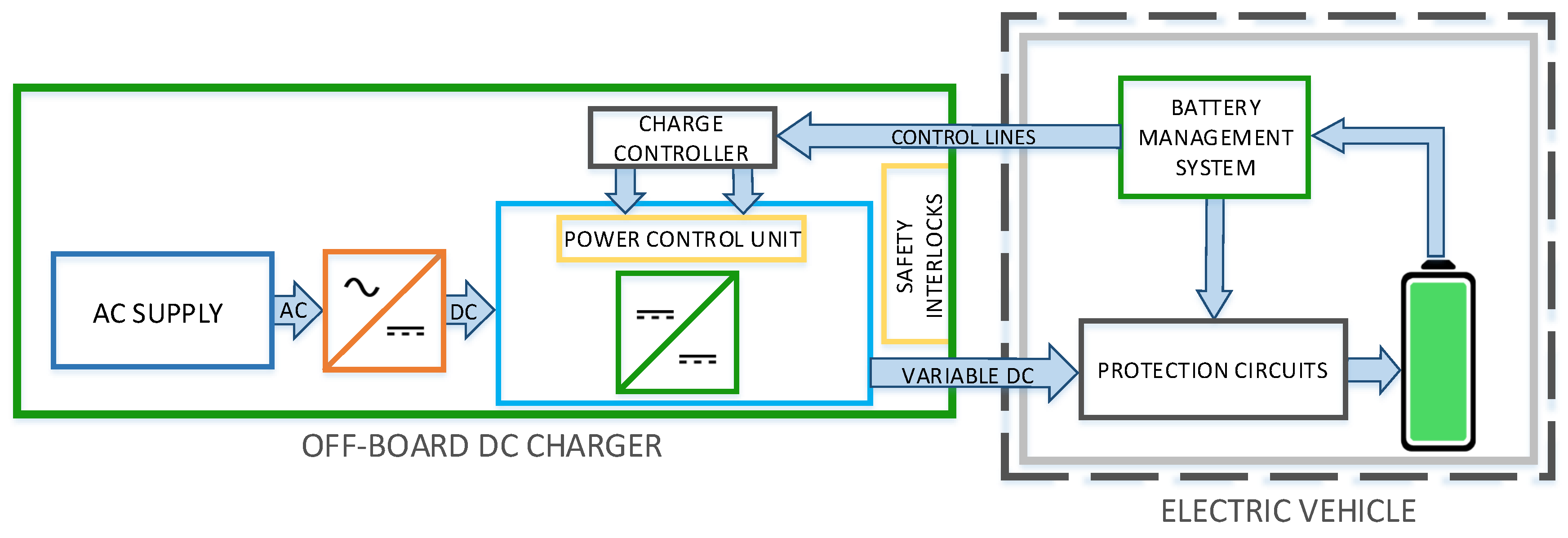
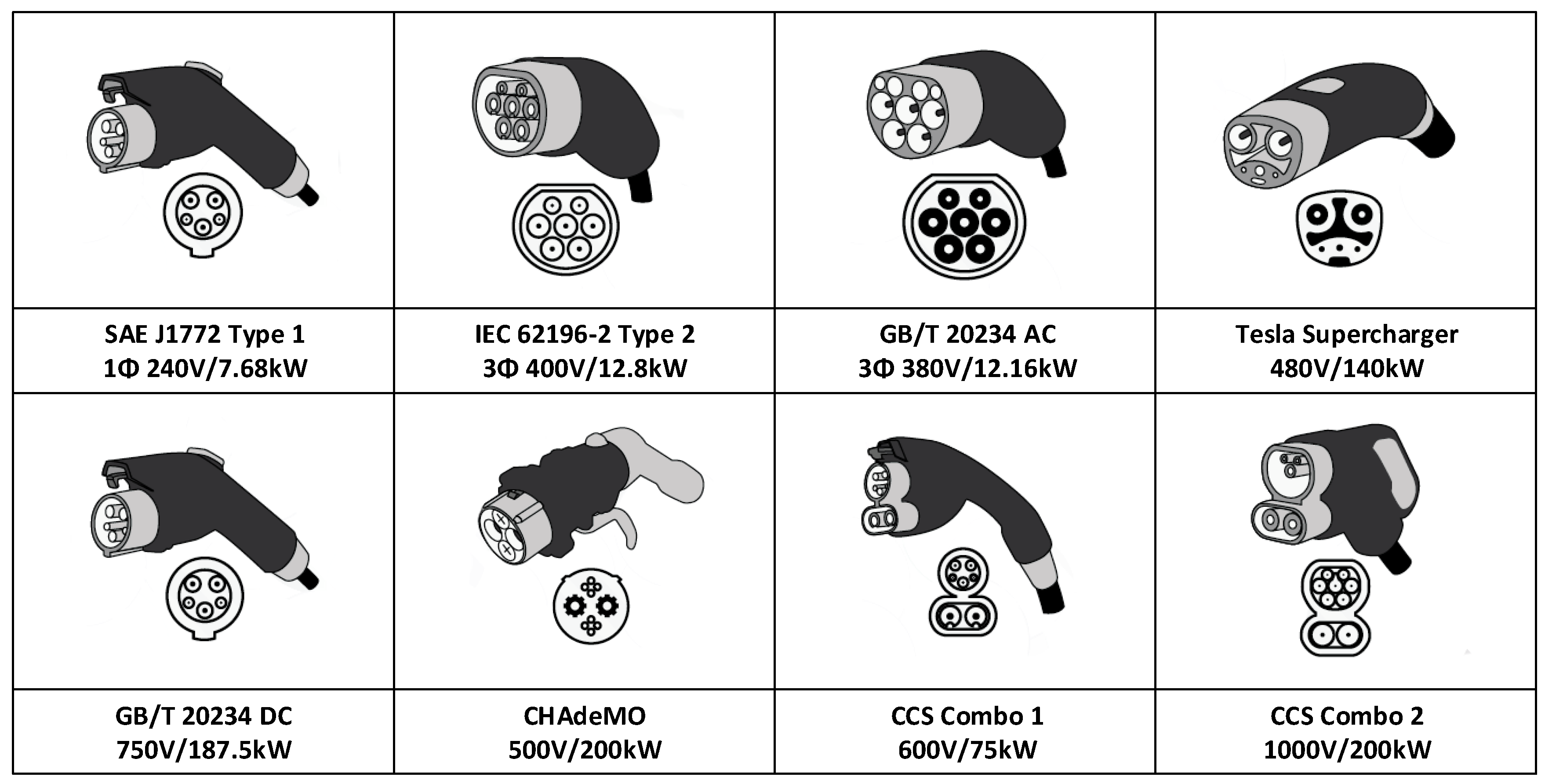

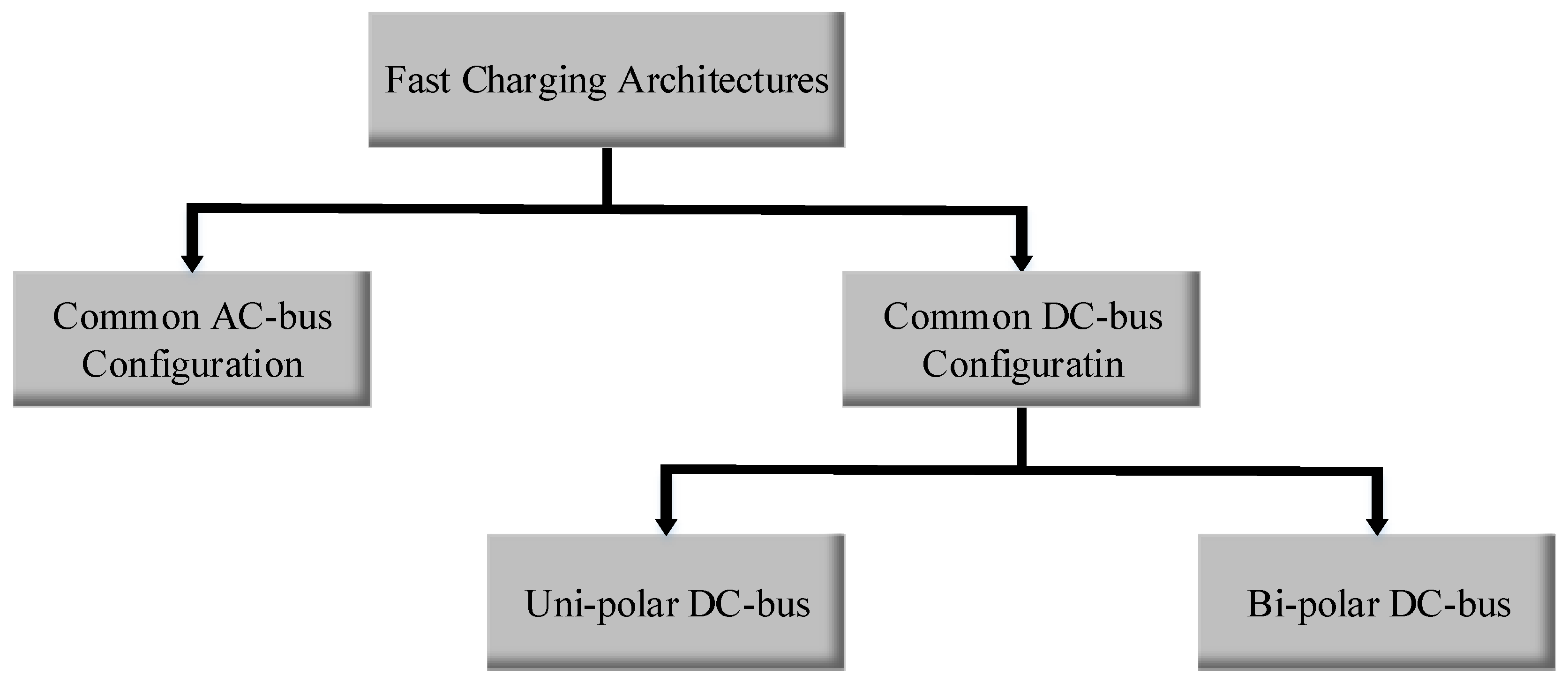
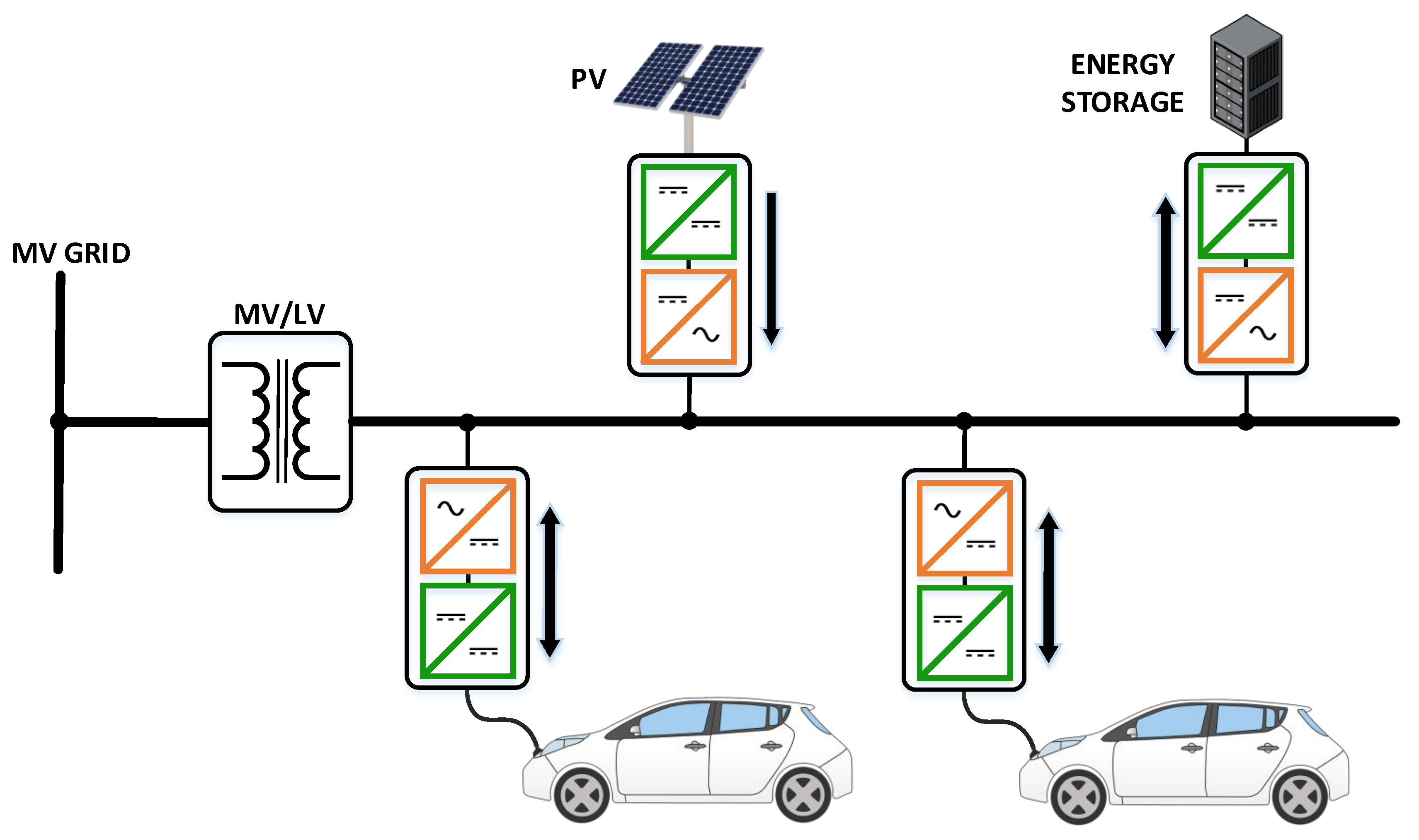
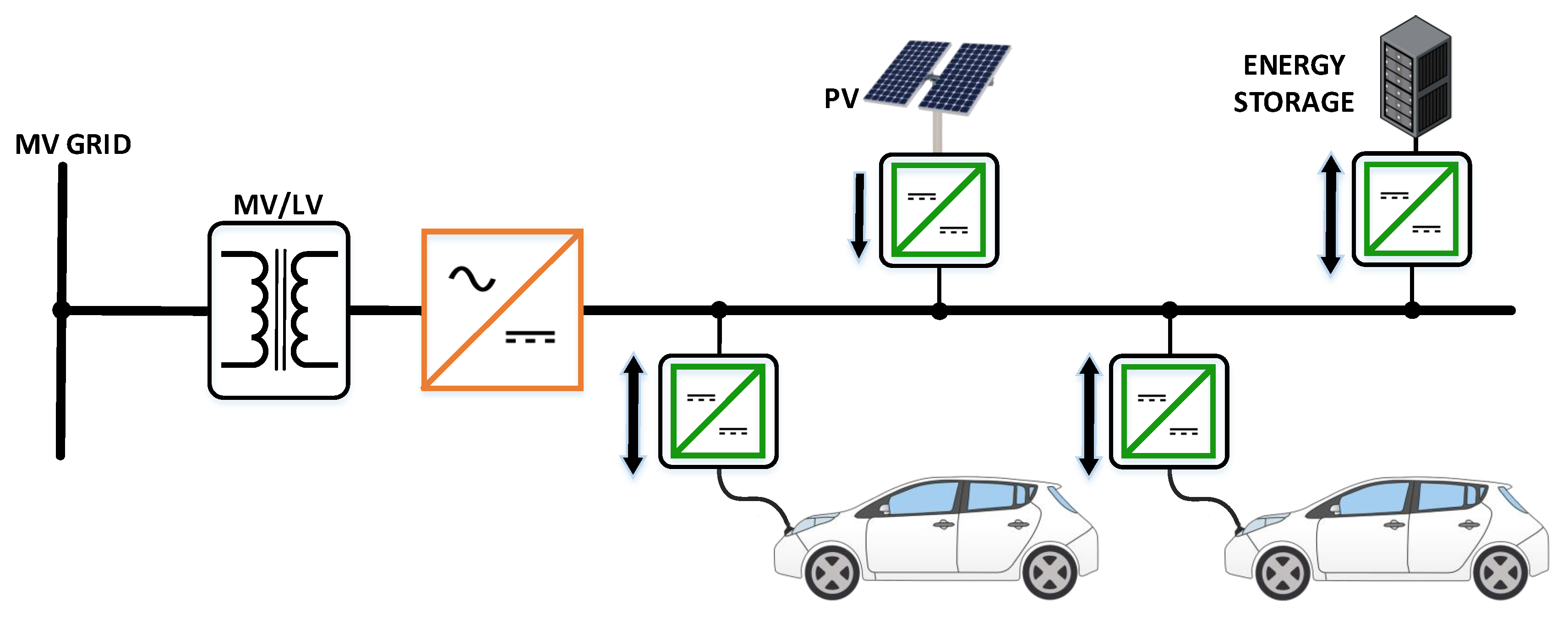
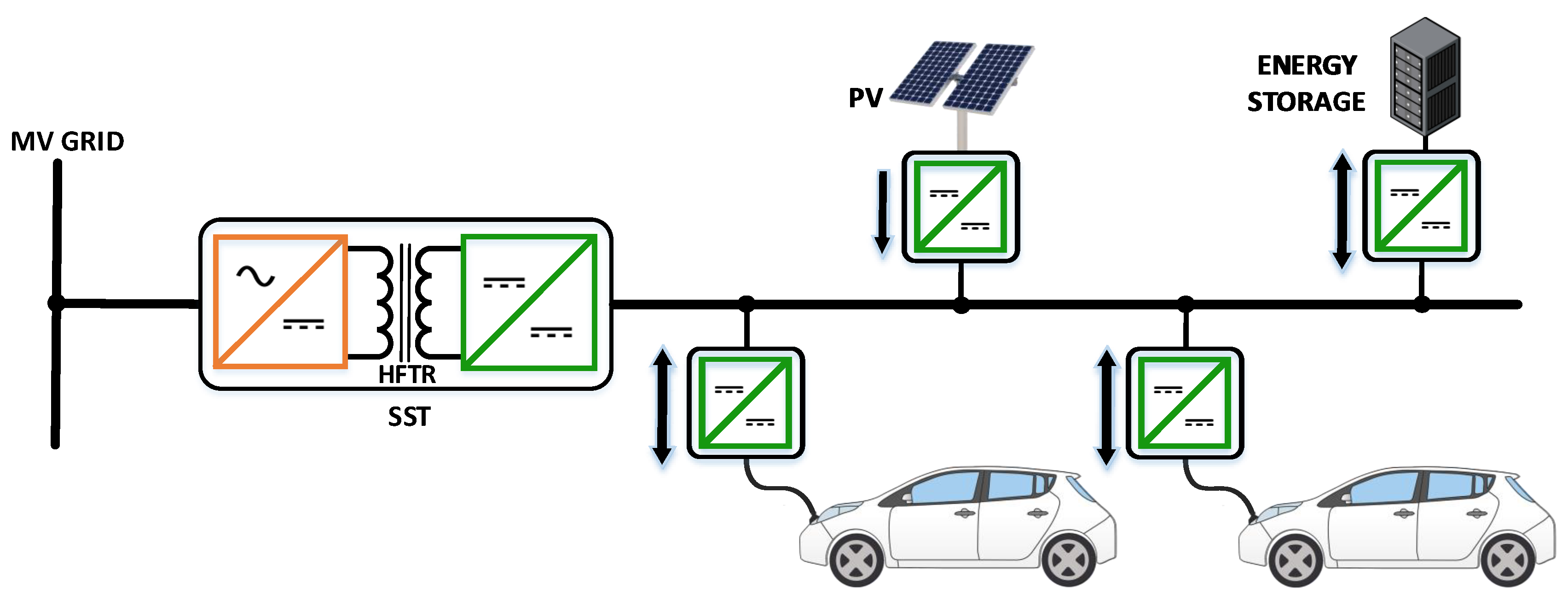
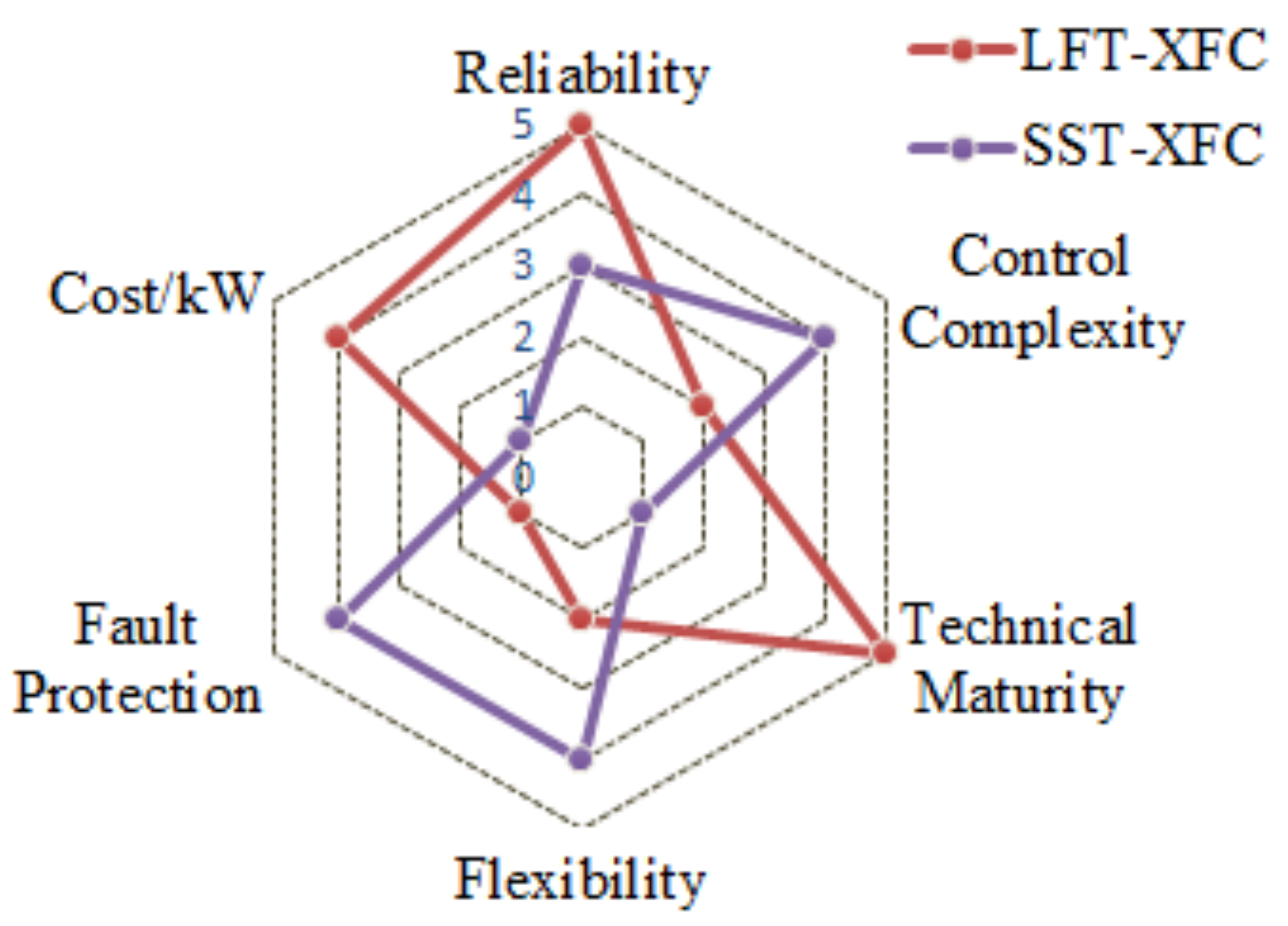

| Vehicle Model | Motor Rating (kW) | Motor | Battery Capacity (kWh) | Electric Range (mil) |
|---|---|---|---|---|
| Smart FortoWo ED | 55 | PMSM | 17.6 | 58 |
| Hyundai Ioniq Elec. | 88 | PMSM | 28 | 124 |
| Mahindra Reva | 35 | IM | 16 | 75 |
| Kia Soul EV | 81 | PMSM | 30 | 110 |
| Renault Zoe | 80 | PMSM | 41 | 250 |
| Tesla Model 3 | 192 | PMSM | 75 | 220 |
| Tesla Model S 70D BEV | 100 | IM | 100 | 240 |
| Chevy Bolt | 150 | PMSM | 60 | 238 |
| Chevy Volt PHEV | 87 | PMSM | 18.4 | 420 |
| Ford Focus Electric | 107 | PMSM | 33.5 | 115 |
| Nissan LEAF BEV | 110 | PMSM | 40 | 151 |
| BMW i3 BEV | 125 | PMSM | 33 | 114 |
| Audi A3 e-Tron PHEV | 75 | PM-SynRM | 8.8 | 31 |
| Toyota Prius PHEV | 50 | PMSM | 8.8 | 640 |
| Cadillac CT6 PHEV | 250 | PMSM | 18.4 | 31 |
| VW e-Golf | 100 | IM | 35.8 | 125 |
| Chery eQ | 41 | PMSM | 23.6 | 157 |
| NIO EP9 | 1000 | PMSM | 90 | 265 |
| Tesla Model X | 193 | IM | 100 | 325 |
| Charging Level | Voltage Level | Maximum Power (kW) | Charging Time | China | Europe | Japan | North America |
|---|---|---|---|---|---|---|---|
| Level 1 (Slow) | 120 VAC | 3.7 | 10–15 hrs | Private outlets (not specific for EVSE) | SAE J1772 (Type 1) | ||
| Level 2 (Slow) | 220 VAC | 3.7–22 | 3.5–7 hrs | GB/T 20234 (AC) | IEC 62196 (Type 2) | SAE J1772 (Type 1) | SAE J1772 (Type 1) |
| Level 3 (Fast) | 3- 480 VAC | 22–43.5 | 10–30 min | GB/T 20234 (AC) | IEC 62196 (Type 2) | SAE J3068 | |
| 200-600 VDC | <200 | GB/T 20234 DC | CCS Combo 2 | CHAdeMO | CCS Combo 1 | ||
| <150 | Tesla and CHAdeMO | ||||||
| XFC | >800 | >400 | ∼gas refuelling | CCS/CHAdeMO | |||
| Fast Charger | Tesla Terra HP | EFAECE-QC45 | Tritium Veefil PK | Delta Ultra Fast | EVTec Espresso |
|---|---|---|---|---|---|
| Input Voltage Range (AC) [V] | 3- 400 | 3- 480 | 3- 480 | 3- 400 | 3- 480 |
| Full Load Power Factor | >0.99 | 0.98 | 0.95 | 0.99 | 0.93 |
| Efficiency [%] | 95 | 93 | 98.5 | 94 | 93 |
| Output Voltage Range (DC) [V] | 150–920 | 50–500 | 920 | 170–550 | 170–500 |
| Output Current [A] | 375/500 | 120 | 500 | 300 | 300 |
| Output Power [kW] | 150 | 50 | 475 | 150 | 120 |
| Charging Connector | CHAdeMO 1.2 | ChadeMO/Combo-1 | CHAdeMO/CCS | CHAdeMO/CCS | CHAdeMO/CCS |
| Dimensions (H×W×D) [mm] | 2103 × 1170 × 770 | 1800 × 600 × 600 | 1998 × 980 × 525 | 2079 × 998 × 852 | 2000 × 930 × 850 |
| Weight [kg] | 350 | 600 | 700 | 400 | 400 |
| Parameter | AC Coupled System | DC Coupled System |
|---|---|---|
| Technical Maturity | High | Low |
| Availability | High | Low |
| Complexity of Protective Devices | Low | High |
| Conversion Stages | High | Low |
| Efficiency | Low | High |
| Control Complexity | High | Low |
| Operation at grid abnormality | No | Yes |
| Cost | High | Low |
| Parameters | Ferrite | Amorphous | Nanocrystalline |
|---|---|---|---|
| Permeability | 1.5–15 k | 1–100 k | 20–200 k |
| Magnetostriction | (20–30) × 10 | <0.2 × 10 | (1–6) × 10 |
| Curie Temperature (K) | 493.15 | >623.15 | >823.15 |
| Operating Temperature (K) | 373–423 | 393–423 | 393-453 |
| Saturation Flux Density (T) | 0.3–0.5 | 0.8–1.5 | 1.1–1.3 |
| Composition | MnZn | (Co)x(SiB)y | FeCuNbSiB |
| Loss (20 kHz, 0.2 T) (W/Kg) | 15–20 | 5–7 | 4–8 |
| Operating Frequency | High | Medium | Medium |
| Cost | Low | Medium | High |
© 2019 by the authors. Licensee MDPI, Basel, Switzerland. This article is an open access article distributed under the terms and conditions of the Creative Commons Attribution (CC BY) license (http://creativecommons.org/licenses/by/4.0/).
Share and Cite
Ronanki, D.; Kelkar, A.; Williamson, S.S. Extreme Fast Charging Technology—Prospects to Enhance Sustainable Electric Transportation. Energies 2019, 12, 3721. https://doi.org/10.3390/en12193721
Ronanki D, Kelkar A, Williamson SS. Extreme Fast Charging Technology—Prospects to Enhance Sustainable Electric Transportation. Energies. 2019; 12(19):3721. https://doi.org/10.3390/en12193721
Chicago/Turabian StyleRonanki, Deepak, Apoorva Kelkar, and Sheldon S. Williamson. 2019. "Extreme Fast Charging Technology—Prospects to Enhance Sustainable Electric Transportation" Energies 12, no. 19: 3721. https://doi.org/10.3390/en12193721
APA StyleRonanki, D., Kelkar, A., & Williamson, S. S. (2019). Extreme Fast Charging Technology—Prospects to Enhance Sustainable Electric Transportation. Energies, 12(19), 3721. https://doi.org/10.3390/en12193721







